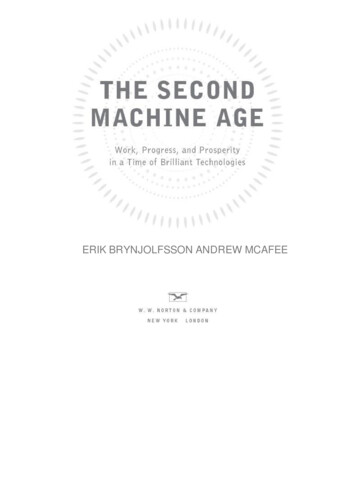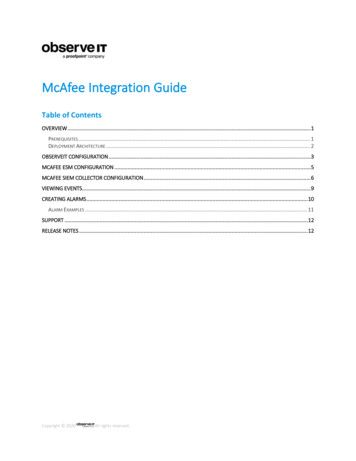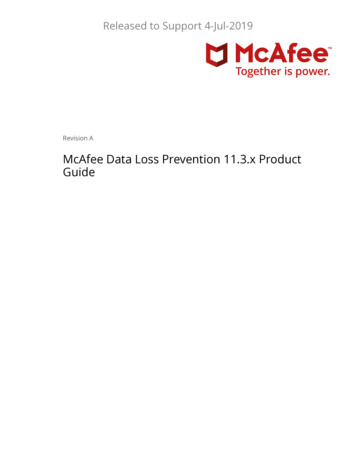
Transcription
ERIK BRYNJOLFSSON ANDREW MCAFEE
To Martha Pavlakis, the love of my life.To my parents, David McAfee and Nancy Haller, who prepared me for the second machine ageby giving me every advantage a person could have.
Chapter 1 THE BIG STORIESChapter 2 THE SKILLS OF THE NEW MACHINES: TECHNOLOGY RACES AHEADChapter 3 MOORE’S LAW AND THE SECOND HALF OF THE CHESSBOARDChapter 4 THE DIGITIZATION OF JUST ABOUT EVERYTHINGChapter 5 INNOVATION: DECLINING OR RECOMBINING?Chapter 6 ARTIFICIAL AND HUMAN INTELLIGENCE IN THE SECOND MACHINE AGEChapter 7 COMPUTING BOUNTYChapter 8 BEYOND GDPChapter 9 THE SPREADChapter 10 THE BIGGEST WINNERS: STARS AND SUPERSTARSChapter 11 IMPLICATIONS OF THE BOUNTY AND THE SPREADChapter 12 LEARNING TO RACE WITH MACHINES: RECOMMENDATIONS FORINDIVIDUALSChapter 13 POLICY RECOMMENDATIONSChapter 14 LONG-TERM RECOMMENDATIONSChapter 15 TECHNOLOGY AND THE FUTURE(Which Is Very Different from “Technology Is the Future”)
AcknowledgmentsNotesIllustration SourcesIndex
“Technology is a gift of God. After the gift of life it is perhaps the greatest of God’s gifts. It is the mother of civilizations, ofarts and of sciences.”—Freeman Dyson
WHAT HAVE BEEN THE most important developments in human history?As anyone investigating this question soon learns, it’s difficult to answer. For one thing, whendoes ‘human history’ even begin? Anatomically and behaviorally modern Homo sapiens,equipped with language, fanned out from their African homeland some sixty thousand years ago.1By 25,000 BCE2 they had wiped out the Neanderthals and other hominids, and thereafter facedno competition from other big-brained, upright-walking species.We might consider 25,000 BCE a reasonable time to start tracking the big stories ofhumankind, were it not for the development-retarding ice age earth was experiencing at the time.3In his book Why the West Rules—For Now, anthropologist Ian Morris starts tracking humansocietal progress in 14,000 BCE, when the world clearly started getting warmer.Another reason it’s a hard question to answer is that it’s not clear what criteria we should use:what constitutes a truly important development? Most of us share a sense that it would be anevent or advance that significantly changes the course of things—one that ‘bends the curve’ ofhuman history. Many have argued that the domestication of animals did just this, and is one ofour earliest important achievements.The dog might well have been domesticated before 14,000 BCE, but the horse was not; eightthousand more years would pass before we started breeding them and keeping them in corrals.The ox, too, had been tamed by that time (ca. 6,000 BCE) and hitched to a plow. Domesticationof work animals hastened the transition from foraging to farming, an important developmentalready underway by 8,000 BCE.4Agriculture ensures plentiful and reliable food sources, which in turn enable larger humansettlements and, eventually, cities. Cities in turn make tempting targets for plunder and conquest.A list of important human developments should therefore include great wars and the empires theyyielded. The Mongol, Roman, Arab, and Ottoman empires—to name just four—weretransformative; they affected kingdoms, commerce, and customs over immense areas.Of course, some important developments have nothing to do with animals, plants, or fightingmen; some are simply ideas. Philosopher Karl Jaspers notes that Buddha (563–483 BCE),Confucius (551–479 BCE), and Socrates (469–399 BCE) all lived quite close to one another intime (but not in place). In his analysis these men are the central thinkers of an ‘Axial Age’spanning 800–200 BCE. Jaspers calls this age “a deep breath bringing the most lucidconsciousness” and holds that its philosophers brought transformative schools of thought to threemajor civilizations: Indian, Chinese, and European.5The Buddha also founded one of the world’s major religions, and common sense demandsthat any list of major human developments include the establishment of other major faiths likeHinduism, Judaism, Christianity, and Islam. Each has influenced the lives and ideals of hundredsof millions of people.6Many of these religions’ ideas and revelations were spread by the written word, itself afundamental innovation in human history. Debate rages about precisely when, where, and howwriting was invented, but a safe estimate puts it in Mesopotamia around 3,200 BCE. Writtensymbols to facilitate counting also existed then, but they did not include the concept of zero, asbasic as that seems to us now. The modern numbering system, which we call Arabic, arrivedaround 830 CE.7The list of important developments goes on and on. The Athenians began to practicedemocracy around 500 BCE. The Black Death reduced Europe’s population by at least 30percent during the latter half of the 1300s. Columbus sailed the ocean blue in 1492, beginninginteractions between the New World and the Old that would transform both.The History of Humanity in One Graph
How can we ever get clarity about which of these developments is the most important? All of thecandidates listed above have passionate advocates—people who argue forcefully andpersuasively for one development’s sovereignty over all the others. And in Why the West Rules—For Now Morris confronts a more fundamental debate: whether any attempt to rank or comparehuman events and developments is meaningful or legitimate. Many anthropologists and othersocial scientists say it is not. Morris disagrees, and his book boldly attempts to quantify humandevelopment. As he writes, “reducing the ocean of facts to simple numerical scores hasdrawbacks but it also has the one great merit of forcing everyone to confront the same evidence—with surprising results.”8 In other words, if we want to know which developments bent the curveof human history, it makes sense to try to draw that curve.Morris has done thoughtful and careful work to quantify what he terms social development (“agroup’s ability to master its physical and intellectual environment to get things done”) over time.*As Morris suggests, the results are surprising. In fact, they’re astonishing. They show that none ofthe developments discussed so far has mattered very much, at least in comparison to somethingelse—something that bent the curve of human history like nothing before or since. Here’s thegraph, with total worldwide human population graphed over time along with social development;as you can see, the two lines are nearly identical:FIGURE 1.1 Numerically Speaking, Most of Human History Is Boring.For many thousands of years, humanity was a very gradual upward trajectory. Progress wasachingly slow, almost invisible. Animals and farms, wars and empires, philosophies and religionsall failed to exert much influence. But just over two hundred years ago, something sudden andprofound arrived and bent the curve of human history—of population and social development—almost ninety degrees.Engines of ProgressBy now you’ve probably guessed what it was. This is a book about the impact of technology, afterall, so it’s a safe bet that we’re opening it this way in order to demonstrate how importanttechnology has been. And the sudden change in the graph in the late eighteenth century
corresponds to a development we’ve heard a lot about: the Industrial Revolution, which was thesum of several nearly simultaneous developments in mechanical engineering, chemistry,metallurgy, and other disciplines. So you’ve most likely figured out that these technologicaldevelopments underlie the sudden, sharp, and sustained jump in human progress.If so, your guess is exactly right. And we can be even more precise about which technologywas most important. It was the steam engine or, to be more precise, one developed and improvedby James Watt and his colleagues in the second half of the eighteenth century.Prior to Watt, steam engines were highly inefficient, harnessing only about one percent of theenergy released by burning coal. Watt’s brilliant tinkering between 1765 and 1776 increased thismore than threefold.9 As Morris writes, this made all the difference: “Even though [the steam]revolution took several decades to unfold . . . it was nonetheless the biggest and fastesttransformation in the entire history of the world.”10The Industrial Revolution, of course, is not only the story of steam power, but steam started itall. More than anything else, it allowed us to overcome the limitations of muscle power, humanand animal, and generate massive amounts of useful energy at will. This led to factories andmass production, to railways and mass transportation. It led, in other words, to modern life. TheIndustrial Revolution ushered in humanity’s first machine age—the first time our progress wasdriven primarily by technological innovation—and it was the most profound time of transformationour world has ever seen.* The ability to generate massive amounts of mechanical power was soimportant that, in Morris’s words, it “made mockery of all the drama of the world’s earlier history.”11FIGURE 1.2 What Bent the Curve of Human History? The Industrial Revolution.Now comes the second machine age. Computers and other digital advances are doing formental power—the ability to use our brains to understand and shape our environments—whatthe steam engine and its descendants did for muscle power. They’re allowing us to blow pastprevious limitations and taking us into new territory. How exactly this transition will play outremains unknown, but whether or not the new machine age bends the curve as dramatically asWatt’s steam engine, it is a very big deal indeed. This book explains how and why.For now, a very short and simple answer: mental power is at least as important for progressand development—for mastering our physical and intellectual environment to get things done—
as physical power. So a vast and unprecedented boost to mental power should be a great boostto humanity, just as the ealier boost to physical power so clearly was.Playing Catch-UpWe wrote this book because we got confused. For years we have studied the impact of digitaltechnologies like computers, software, and communications networks, and we thought we had adecent understanding of their capabilities and limitations. But over the past few years, theystarted surprising us. Computers started diagnosing diseases, listening and speaking to us, andwriting high-quality prose, while robots started scurrying around warehouses and driving carswith minimal or no guidance. Digital technologies had been laughably bad at a lot of these thingsfor a long time—then they suddenly got very good. How did this happen? And what were theimplications of this progress, which was astonishing and yet came to be considered a matter ofcourse?We decided to team up and see if we could answer these questions. We did the normal thingsbusiness academics do: read lots of papers and books, looked at many different kinds of data,and batted around ideas and hypotheses with each other. This was necessary and valuable, butthe real learning, and the real fun, started when we went out into the world. We spoke withinventors, investors, entrepreneurs, engineers, scientists, and many others who make technologyand put it to work.Thanks to their openness and generosity, we had some futuristic experiences in today’sincredible environment of digital innovation. We’ve ridden in a driverless car, watched acomputer beat teams of Harvard and MIT students in a game of Jeopardy!, trained an industrialrobot by grabbing its wrist and guiding it through a series of steps, handled a beautiful metal bowlthat was made in a 3D printer, and had countless other mind-melting encounters with technology.Where We AreThis work led us to three broad conclusions.The first is that we’re living in a time of astonishing progress with digital technologies—thosethat have computer hardware, software, and networks at their core. These technologies are notbrand-new; businesses have been buying computers for more than half a century, and Timemagazine declared the personal computer its “Machine of the Year” in 1982. But just as it tookgenerations to improve the steam engine to the point that it could power the Industrial Revolution,it’s also taken time to refine our digital engines.We’ll show why and how the full force of these technologies has recently been achieved andgive examples of its power. “Full,” though, doesn’t mean “mature.” Computers are going tocontinue to improve and to do new and unprecedented things. By “full force,” we mean simplythat the key building blocks are already in place for digital technologies to be as important andtransformational to society and the economy as the steam engine. In short, we’re at an inflectionpoint—a point where the curve starts to bend a lot—because of computers. We are entering asecond machine age.Our second conclusion is that the transformations brought about by digital technology will beprofoundly beneficial ones. We’re heading into an era that won’t just be different; it will be better,because we’ll be able to increase both the variety and the volume of our consumption. When wephrase it that way—in the dry vocabulary of economics—it almost sounds unappealing. Whowants to consume more and more all the time? But we don’t just consume calories and gasoline.We also consume information from books and friends, entertainment from superstars and
amateurs, expertise from teachers and doctors, and countless other things that are not made ofatoms. Technology can bring us more choice and even freedom.When these things are digitized—when they’re converted into bits that can be stored on acomputer and sent over a network—they acquire some weird and wonderful properties. They’resubject to different economics, where abundance is the norm rather than scarcity. As we’ll show,digital goods are not like physical ones, and these differences matter.Of course, physical goods are still essential, and most of us would like them to have greatervolume, variety, and quality. Whether or not we want to eat more, we’d like to eat better ordifferent meals. Whether or not we want to burn more fossil fuels, we’d like to visit more placeswith less hassle. Computers are helping accomplish these goals, and many others. Digitization isimproving the physical world, and these improvements are only going to become more important.Among economic historians there’s wide agreement that, as Martin Weitzman puts it, “the longterm growth of an advanced economy is dominated by the behavior of technical progress.”12 Aswe’ll show, technical progress is improving exponentially.Our third conclusion is less optimistic: digitization is going to bring with it some thornychallenges. This in itself should not be too surprising or alarming; even the most beneficialdevelopments have unpleasant consequences that must be managed. The Industrial Revolutionwas accompanied by soot-filled London skies and horrific exploitation of child labor. What will betheir modern equivalents? Rapid and accelerating digitization is likely to bring economic ratherthan environmental disruption, stemming from the fact that as computers get more powerful,companies have less need for some kinds of workers. Technological progress is going to leavebehind some people, perhaps even a lot of people, as it races ahead. As we’ll demonstrate,there’s never been a better time to be a worker with special skills or the right education, becausethese people can use technology to create and capture value. However, there’s never been aworse time to be a worker with only ‘ordinary’ skills and abilities to offer, because computers,robots, and other digital technologies are acquiring these skills and abilities at an extraordinaryrate.Over time, the people of England and other countries concluded that some aspects of theIndustrial Revolution were unacceptable and took steps to end them (democratic governmentand technological progress both helped with this). Child labor no longer exists in the UK, andLondon air contains less smoke and sulfur dioxide now than at any time since at least the late1500s.13 The challenges of the digital revolution can also be met, but first we have to be clear onwhat they are. It’s important to discuss the likely negative consequences of the second machineage and start a dialogue about how to mitigate them—we are confident that they’re notinsurmountable. But they won’t fix themselves, either. We’ll offer our thoughts on this importanttopic in the chapters to come.So this is a book about the second machine age unfolding right now—an inflection point in thehistory of our economies and societies because of digitization. It’s an inflection point in the rightdirection—bounty instead of scarcity, freedom instead of constraint—but one that will bring with itsome difficult challenges and choices.This book is divided into three sections. The first, composed of chapters 1 through 6, describesthe fundamental characteristics of the second machine age. These chapters give many examplesof recent technological progress that seem like the stuff of science fiction, explain why they’rehappening now (after all, we’ve had computers for decades), and reveal why we should beconfident that the scale and pace of innovation in computers, robots, and other digital gear is onlygoing to accelerate in the future.The second part, consisting of chapters 7 through 11, explores bounty and spread, the twoeconomic consequences of this progress. Bounty is the increase in volume, variety, and quality
and the decrease in cost of the many offerings brought on by modern technological progress. It’sthe best economic news in the world today. Spread, however, is not so great; it’s ever-biggerdifferences among people in economic success—in wealth, income, mobility, and other importantmeasures. Spread has been increasing in recent years. This is a troubling development for manyreasons, and one that will accelerate in the second machine age unless we intervene.The final section—chapters 12 through 15—discusses what interventions will be appropriateand effective for this age. Our economic goals should be to maximize the bounty while mitigatingthe negative effects of the spread. We’ll offer our ideas about how to best accomplish these aims,both in the short term and in the more distant future, when progress really has brought us into aworld so technologically advanced that it seems to be the stuff of science fiction. As we stress inour concluding chapter, the choices we make from now on will determine what kind of world thatis.* Morris defines human social development as consisting of four attributes: energy capture (per-person calories obtained fromthe environment for food, home and commerce, industry and agriculture, and transportation), organization (the size of thelargest city), war-making capacity (number of troops, power and speed of weapons, logistical capabilities, and other similarfactors), and information technology (the sophistication of available tools for sharing and processing information, and theextent of their use). Each of these is converted into a number that varies over time from zero to 250. Overall social developmentis simply the sum of these four numbers. Because he was interested in comparisons between the West (Europe, Mesopotamia,and North America at various times, depending on which was most advanced) and the East (China and Japan), he calculatedsocial development separately for each area from 14,000 BCE to 2000 CE. In 2000, the East was higher only in organization(since Tokyo was the world’s largest city) and had a social development score of 564.83. The West’s score in 2000 was906.37. We average the two scores.* We refer to the Industrial Revolution as the first machine age. However, “the machine age” is also a label used by someeconomic historians to refer to a period of rapid technological progress spanning the late nineteenth and early twentiethcenturies. This same period is called by others the Second Industrial Revolution, which is how we’ll refer to it in later chapters.
“Any sufficiently advanced technology is indistinguishable from magic.”—Arthur C. Clarke
IN THE SUMMER OF 2012, we went for a drive in a car that had no driver.During a research visit to Google’s Silicon Valley headquarters, we got to ride in one of thecompany’s autonomous vehicles, developed as part of its Chauffeur project. Initially we hadvisions of cruising in the back seat of a car that had no one in the front seat, but Google isunderstandably skittish about putting obviously autonomous autos on the road. Doing so mightfreak out pedestrians and other drivers, or attract the attention of the police. So we sat in the backwhile two members of the Chauffeur team rode up front.When one of the Googlers hit the button that switched the car into fully automatic driving modewhile we were headed down Highway 101, our curiosities—and self-preservation instincts—engaged. The 101 is not always a predictable or calm environment. It’s nice and straight, but it’salso crowded most of the time, and its traffic flows have little obvious rhyme or reason. Athighway speeds the consequences of driving mistakes can be serious ones. Since we were nowpart of the ongoing Chauffeur experiment, these consequences were suddenly of more than justintellectual interest to us.The car performed flawlessly. In fact, it actually provided a boring ride. It didn’t speed or slalomamong the other cars; it drove exactly the way we’re all taught to in driver’s ed. A laptop in the carprovided a real-time visual representation of what the Google car ‘saw’ as it proceeded along thehighway—all the nearby objects of which its sensors were aware. The car recognized all thesurrounding vehicles, not just the nearest ones, and it remained aware of them no matter wherethey moved. It was a car without blind spots. But the software doing the driving was aware thatcars and trucks driven by humans do have blind spots. The laptop screen displayed thesoftware’s best guess about where all these blind spots were and worked to stay out of them.We were staring at the screen, paying no attention to the actual road, when traffic ahead of uscame to a complete stop. The autonomous car braked smoothly in response, coming to a stop asafe distance behind the car in front, and started moving again once the rest of the traffic did. Allthe while the Googlers in the front seat never stopped their conversation or showed anynervousness, or indeed much interest at all in current highway conditions. Their hundreds ofhours in the car had convinced them that it could handle a little stop-and-go traffic. By the time wepulled back into the parking lot, we shared their confidence.The New New Division of LaborOur ride that day on the 101 was especially weird for us because, only a few years earlier, wewere sure that computers would not be able to drive cars. Excellent research and analysis,conducted by colleagues who we respect a great deal, concluded that driving would remain ahuman task for the foreseeable future. How they reached this conclusion, and how technologieslike Chauffeur started to overturn it in just a few years, offers important lessons about digitalprogress.In 2004 Frank Levy and Richard Murnane published their book The New Division of Labor.1The division they focused on was between human and digital labor—in other words, betweenpeople and computers. In any sensible economic system, people should focus on the tasks andjobs where they have a comparative advantage over computers, leaving computers the work forwhich they are better suited. In their book Levy and Murnane offered a way to think about whichtasks fell into each category.One hundred years ago the previous paragraph wouldn’t have made any sense. Back then,computers were humans. The word was originally a job title, not a label for a type of machine.Computers in the early twentieth century were people, usually women, who spent all day doingarithmetic and tabulating the results. Over the course of decades, innovators designed machines
that could take over more and more of this work; they were first mechanical, then electromechanical, and eventually digital. Today, few people if any are employed simply to doarithmetic and record the results. Even in the lowest-wage countries there are no humancomputers, because the nonhuman ones are far cheaper, faster, and more accurate.If you examine their inner workings, you realize that computers aren’t just number crunchers,they’re symbols processors. Their circuitry can be interpreted in the language of ones andzeroes, but equally validly as true or false, yes or no, or any other symbolic system. In principle,they can do all manner of symbolic work, from math to logic to language. But digital novelists arenot yet available, so people still write all the books that appear on fiction bestseller lists. We alsohaven’t yet computerized the work of entrepreneurs, CEOs, scientists, nurses, restaurantbusboys, or many other types of workers. Why not? What is it about their work that makes itharder to digitize than what human computers used to do?Computers Are Good at Following Rules . . .These are the questions Levy and Murnane tackled in The New Division of Labor, and theanswers they came up with made a great deal of sense. The authors put information processingtasks—the foundation of all knowledge work—on a spectrum. At one end are tasks like arithmeticthat require only the application of well-understood rules. Since computers are really good atfollowing rules, it follows that they should do arithmetic and similar tasks.Levy and Murnane go on to highlight other types of knowledge work that can also beexpressed as rules. For example, a person’s credit score is a good general predictor of whetherthey’ll pay back their mortgage as promised, as is the amount of the mortgage relative to theperson’s wealth, income, and other debts. So the decision about whether or not to give someonea mortgage can be effectively boiled down to a rule.Expressed in words, a mortgage rule might say, “If a person is requesting a mortgage ofamount M and they have a credit score of V or higher, annual income greater than I or totalwealth greater than W, and total debt no greater than D, then approve the request.” Whenexpressed in computer code, we call a mortgage rule like this an algorithm. Algorithms aresimplifications; they can’t and don’t take everything into account (like a billionaire uncle who hasincluded the applicant in his will and likes to rock-climb without ropes). Algorithms do, however,include the most common and important things, and they generally work quite well at tasks likepredicting payback rates. Computers, therefore, can and should be used for mortgage approval.*. . . But Lousy at Pattern RecognitionAt the other end of Levy and Murnane’s spectrum, however, lie information processing tasks thatcannot be boiled down to rules or algorithms. According to the authors, these are tasks that drawon the human capacity for pattern recognition. Our brains are extraordinarily good at taking ininformation via our senses and examining it for patterns, but we’re quite bad at describing orfiguring out how we’re doing it, especially when a large volume of fast-changing informationarrives at a rapid pace. As the philosopher Michael Polanyi famously observed, “We know morethan we can tell.”2 When this is the case, according to Levy and Murnane, tasks can’t becomputerized and will remain in the domain of human workers. The authors cite driving a vehiclein traffic as an example of such as task. As they write,As the driver makes his left turn against traffic, he confronts a wall of images and sounds generated by oncoming cars,traffic lights, storefronts, billboards, trees, and a traffic policeman. Using his knowledge, he must estimate the size andposition of each of these objects and the likelihood that they pose a hazard. . . . The truck driver [has] the schema torecognize what [he is] confronting. But articulating this knowledge and embedding it in software for all but highly
structured situations are at present enormously difficult tasks. . . . Computers cannot easily substitute for humans in [jobslike driving].So Much for That DistinctionWe were convinced by Levy and Murnane’s arguments when we read The New Division ofLabor in 2004. We were further convinced that year by the initial results of the DARPA GrandChallenge for driverless cars.DARPA, the Defense Advanced Research Projects Agency, was founded in 1958 (in responseto the Soviet Union’s launch of the Sputnik satellite) and tasked with spurring technologicalprogress that might have military applications. In 2002 the agency announced its first GrandChallenge, which was to build a completely autonomous vehicle that could complete a 150-milecourse through California’s Mojave Desert. Fifteen entrants performed well enough in aqualifying run to compete in the main event, which was held on March 13, 2004.The results were less than encouraging. Two vehicles didn’t make it to the starting area, oneflipped over in the starting area, and three hours into the race only four cars were still operational.The “winning” Sandstorm car from Carnegie Mellon University covered 7.4 miles (less than 5percent of the total) before veering off the course during a hairpin turn and getting stuck on anembankment. The contest’s 1 million prize went unclaimed, and Popular Science called theevent “DARPA’s Debacle in the Desert.”3Within a few years, however, the debacle in the desert became the ‘fun on the 101’ that weexperienced. Google announced in an October 2010 blog post that its completely autonomouscars had for some time been driving successfully, in traffic, on American roads and highways. Bythe time we took our ride in the summer of 2012 the Chauffeur project had grown into a small fleetof vehicles that had collectively logged hundreds of thousands of mile
Chapter 11 IMPLICATIONS OF THE BOUNTY AND THE SPREAD Chapter 12 LEARNING TO RACE WITH MACHINES: RECOMMENDATIONS FOR INDIVIDUALS Chapter 13 POLICY RECOMMENDATIONS Chapter 14 LONG-TERM RECOMMENDATIONS Chapter 15 TECHNOLOGY AND THE FUTURE (W










